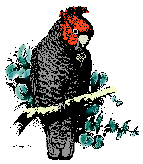Good morning COG/Canberra Birds members and chat line subscribers, a reminder that the monthly COG/Canberra Birds meeting will be held tomorrow evening Wednesday 12 March from
7:30 pm at our usual Canberra Girls Grammar School venue. However, please note the changed access arrangements which will be in place for 2025 while the construction in the Gabriel Drive parking area continues.
The amended map can be accessed through the following link on our web site
COG monthly meeting location - Canberra Birds.
Everyone is welcome so please come along to hear about the potential devastating effect Avian influenza H5N1 could have on Australian bird populations, and to learn more about
the enigmatic Freckled Duck.
There will be the usual raffle, and you will also be able to enjoy a cup of tea or coffee after the meeting.
Jack Holland
The March 2025 meeting will be a normal face-to-face one held at our usual venue. As COVID is still widespread in the community attendees should heed social distancing and
good hygiene practice etc, and use their common sense and stay home if they have COVID symptoms. Mask wearing is recommended.
Rachael Grigson – Avian influenza H5N1…no longer a matter of if, but when?
Geoffrey Dabb – ‘Uncommon non-breeding visitor’: some reflections on the intermittent
Freckled Duck, one of Canberra’s most interesting birds.
Please note that construction is still occurring around the Gabriel Drive parking area, and access to there is still not available. However, for 2025 the access gate and
parking spot has changed. Entry and exit are now from the main gates on Melbourne Ave which automatically open and close. The Entry gate will be open, so please drive through and park in the main parking area to your left. Once parked proceed to the Multi-media
Theatre (MMT) using the more direct route in the amended map to that provided by the Canberra Girls Grammar School which can be found on our web site using the above link.
This is roughly perpendicular to Melbourne Ave. Keep the Admin Hub, Reception and School Shop to your right and then proceed along a relatively flat and straight broad path
keeping the columns to you left. Near to the end, go left up the 3 m wide steps, turn half right and you will find an open glass door. Go through this, across the empty room and past the toilets, and then enter the MMT either through the bottom MMT door
or go further along and up the steps where you reach the usual entry door.
Though it is well lit, as it will be dark after the meeting and a torch for finding your way back to your car is recommended. The Exit gate is on a sensor pad, so please
drive up to the gate and it will open for you.
The first speaker will be Rachael Grigson,
Biosecurity Veterinarian in the ACT Government, on “Avian influenza
H5N1…no longer a matter of if, but when?”
Australia remains the only continent free from high pathogenicity avian influenza (HPAI) H5N1. Outbreaks overseas have led to mass mortalities of millions of wild birds and
tens of thousands of wild mammals. It has also caused a small number of human infections. With the increased likelihood of entry via migrating wild birds, the risk to Australia is real. Does our unique wildlife stand a chance? Rachael will look at what
has been done, what is being done, what needs to be done, and what we can do as bird lovers.
The main presentation will be by
Geoffrey Dabb on ‘Uncommon non-breeding visitor’: some reflections on the intermittent Freckled Duck, one of Canberra’s most interesting birds.
Geoffrey has provided the following information about his presentation:
This paper began with a curiosity about the comings and goings of
Freckled Ducks (FD), certainly not with any intention of giving a talk on the species. I thought perhaps it could be shown that the feeding requirements of dispersing
Freckled Ducks limited them to water bodies in our area that were of a particular kind and in a particular condition.
A few months ago, I started by making lists grouping all local FD records according to time and location. This shifted my attention to how we have reported and
recorded the occurrence of bird species, and whether this was useful for an intermittent bird species. Our overall observing effort, for understandable reasons, tends to concentrate on certain sites, some much more than others. It can miss visits by this
species, which are often relatively brief. I then consulted the wider literature, to the extent readily available.
I now have a large amount of material of varying relevance including on the early days of observing by COG members. I have made several attempts to try to organize
this in an informative way for a presentation, none really satisfactory so far. However, I am still trying as I write this summary. The main points I hope to be able to talk about are: where (we are told) the species sits among Australian ducks; how it has
a surprising number of historic and current associations with Canberra; what we know about its appearances around the local area; what it is doing when it is present here; and how remarkable numbers of visiting
Freckled Ducks have been recorded at (the intermittently surveyed) Lake George. There’s also something to say about the presence of the species in the Canberra area during 2025 so far.

